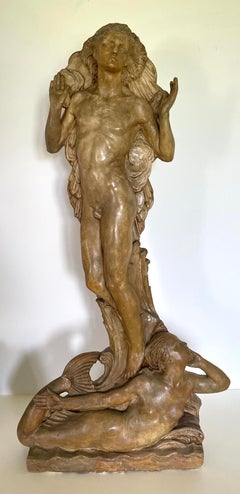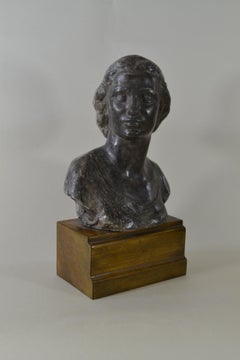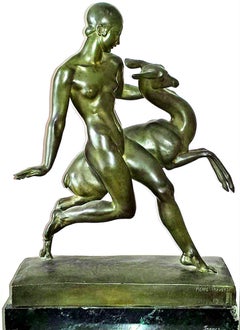Richard Garbe Sculptures
to
3
1
1
1
Overall Height
to
Overall Width
to
2
3
3
3
2
1
1
1
1
3
1
1
3
404
230
229
122
3
Artist: Richard Garbe
Richard Garbe - Helios - Early 20th Century British patinated plaster sculpture
By Richard Garbe
Located in London, GB
RICHARD LOUIS GARBE, RA
(1876-1957)
Helios
Signed and dated 1929
Plaster with patinated surface
86 cm., 33 ¾ in. high
Garbe was born in Dalston, London, the son of Gustave Garbe,...
Category
Early 20th Century Art Deco Richard Garbe Sculptures
Materials
Plaster
The Falconer, Art Deco British Plaster Sculpture by Richard Garbe RA
By Richard Garbe
Located in London, GB
RICHARD GARBE, RA
(1876-1957)
The Falconer
Signed and dated on the reverse: Richard Garbe, ARA / 1932
Patinated plaster
49.5 cm., 19 ½ in. high
Proven...
Category
1930s Art Deco Richard Garbe Sculptures
Materials
Plaster
Alfreda, The Artist's Daughter - British 1950s plaster bust by Richard Garbe
By Richard Garbe
Located in London, GB
RICHARD LOUIS GARBE, RA
(1876-1957)
Alfreda, The Artist’s Daughter
Signed and dated 1956
Plaster with patinated surface on a wooden base
30 cm., 11 ¾ in. high
Provenance:
Gifted ...
Category
1950s Realist Richard Garbe Sculptures
Materials
Plaster
Related Items
Mahatma Gandhi
Located in West Palm Beach, FL
Lladró launched this special commemorative piece coinciding with the 60th anniversary of the death of Mahatma Gandhi (1869-1948). The sculpture is an excellent likeness of the great ...
Category
21st Century and Contemporary Realist Richard Garbe Sculptures
Materials
Porcelain
Art Deco Bronze Nude Girl with Fawn, Amazon with Fawn
By Pierre Traverse
Located in Miami, FL
Signed on base. This was exhibited at the Goldscheider Pavilion at the 1925 Paris Exhibition
Marble base has loss to right edge and very small lose to center edge. , Bronze is in ve...
Category
1920s Art Deco Richard Garbe Sculptures
Materials
Bronze
Vincent Glinsky Alabaster Reclining Nude Sculpture c.1950
Located in San Francisco, CA
Vincent Glinsky Alabaster Reclining Nude Sculpture c.1950
9" long x 4.5" deep x 7.5" high
Signed at the base
Good vintage condition
Vincent Glins...
Category
Mid-20th Century Art Deco Richard Garbe Sculptures
Materials
Alabaster
H 7.5 in W 9 in D 4.5 in
"Pioneer Family" WPA American Modernism Plaster Maquette Realism 20th Century
By William Zorach
Located in New York, NY
"Pioneer Family," 23 1/2 x 16 1/4 x 10 3/4 inPlaster. c. 1927. Unsigned. Realism
The Smithsonian has a cast of this sculpture in its collection. Pictured on the cover of “The Sculpt...
Category
1920s American Modern Richard Garbe Sculptures
Materials
Plaster
Large George Aarons Terracotta Sculpture Relief Art Deco Plaque WPA Artist
By George Aarons
Located in Surfside, FL
Two Figures (Mother and son)
9" x 17" terracotta sculpture, signed lower left mounted to wood panel, 15 1/2" x 23 1/2"
George Aarons (born Gregory Podubisky, in St. Petersburg, Russ...
Category
20th Century Art Deco Richard Garbe Sculptures
Materials
Wood, Terracotta
"La Comete" Iconic French Art Deco Silvered Bronze 1920s Female Nude
By Maurice Guiraud-Rivière
Located in New York, NY
"La Comete" Iconic French Art Deco Silvered Bronze 1920s Female Nude
Maurice Guirard-Riviere (1881 - 1947)
La Comete
Silvered bronze
23 inches wide x 19 3/4 inches high x 5 1/2 inc...
Category
1920s Art Deco Richard Garbe Sculptures
Materials
Bronze
Daniel Arsham FUTURE RELIC 07 CASSETTE PLAYER Limited Sculpture Sony Walkman 90s
By Daniel Arsham
Located in Madrid, Madrid
Daniel Arsham - FUTURE RELIC 07 - CASSETTE PLAYER
Date of creation: 2017
Medium: Plaster and crushed glass
Edition number: 476/500
Size: 12.7 × 14.6 × 14 cm
Condition: In mint condi...
Category
2010s Modern Richard Garbe Sculptures
Materials
Glass, Plaster
Free Shipping
H 5.75 in W 5.75 in D 5.08 in
"Transcendent", Frederick Hart, Acrylic Sculpture, 19x11x9 in., 96/350, white
By Frederick Hart
Located in Dallas, TX
"Transcendent" Dimensions: 19" x 11" x 9" Medium: Clear Acrylic Resin Edition 96/350
Frederick Hart's 1991 “Transcendent” lucite sculpture is imbued with a truly sublime presence. Female and male figures emerging from the Lucite seem to appear and disappear within the work. This ghostly effect is created through Hart’s unique process of embedment, which involves casting one acrylic work within another. It is a technique the artist patented in 1982, marking the end of a decade of constant experimentation and progression and the beginning of a period of precise refinement. Consistent with his unique poetic vision, the inner, emotional, intellectual, and spiritual forces dominate the work. Imbued with a distinct sense of grace, this piece is a testament to Hart’s remarkable technical abilities and devotion to the craft.
Frederick Hart's "Transcendent" is signed by the artist and includes a gallery certificate of authenticity. It is from an edition of 350 (+ 60 AP) and the current gallery retail price for the piece is over $40,000.
About Frederick Hart
As one of America’s greatest representational artists, Frederick Hart left a lasting and unique mark in the world of modern sculpture. Born in Atlanta, Georgia in 1943, he studied at the University of South Carolina and after protesting alongside black students during the Civil rights movement, he moved to Washington D.C. to continue his studies at the Corcoran School of Art. Fascinated with the human figure and the classical approach, he started developing his career in 1966 as a stone carver apprentice at the National Cathedral in Washington D.C. Leaving the Cathedral in 1971, Hart started his own studio practice but had little success in the first years. In 1974, he was awarded the project by the Cathedral to create a contemporary interpretation of The Creation, an event that would change his life. Soon, Hart’s career took a turn for the better, and in the upcoming decades, he rose to national prominence, becoming a government art advisor in 1985 and receiving the prestigious Henry Hering...
Category
1990s Realist Richard Garbe Sculptures
Materials
Resin, Acrylic Polymer
Portrait of Ni-Polog
Located in New York, NY
Signed, dated, and inscribed on the verso:
Malvina Hoffman/ Den Pasar/ “Nipolog”-/ © 1932/ Bali
Provenance:
The artist; her estate.
Literature:
Mal...
Category
1930s Realist Richard Garbe Sculptures
Materials
Terracotta
Replica of Wilhelm Lehmbruck's Kneeling Woman
Located in Troy, NY
This sculpture is a small replica of Wilhelm Lehmbuck's Kneeling Woman. The original sculpture is much larger at around 69.5 x 56 x 27", currently at th...
Category
1960s Expressionist Richard Garbe Sculptures
Materials
Wood, Plaster
"Ground Zero" Bronze German Shepherd Dog Searching for Survivors
Located in Brookville, NY
This sculptor is not only an artist, but a vetrinarian. She knows anatomy as well as she knows breeds and behaviors.. This beautiful bronze depicts a German Shepherd Dog searching ...
Category
Early 2000s Realist Richard Garbe Sculptures
Materials
Bronze
Plaster Sculpture Relief Art Deco Plaque WPA Artist Peace Swords to Ploughshares
By George Aarons
Located in Surfside, FL
Size includes wood mounting.
George Aarons (born Gregory Podubisky, in St. Petersburg, Russia, 1896 - died in Gloucester, Massachusetts 1980) was a distinguished sculptor who lived and taught in Gloucester, Massachusetts, for many years until his death in 1980. He had, many students in the area and he designed Gloucester's 350th Anniversary Commemorative Medal.
Aarons moved from Russia to the United States when he was ten. His father was a merchant. He began taking drawing classes during evenings at Dearborn Public School in Boston as a teenager and went on to study at the Boston Museum of Fine Arts in 1916. Aarons later moved to New York City to study with Jo Davidson, and other Paris-trained masters at the Beaux-Arts Institute. He eventually returned to the Boston area and established studios in Brookline and Gloucester, Massachusetts. During his lifetime, he was recognized internationally and won several prestigious awards. Aarons had studios in Brookline, Massachusetts and Gloucester, Massachusetts where he produced large bronze and marble figures and wood carvings. He produced several projects for the Works Progress Administration including a group of three figures for the Public Garden (Boston), a longshoreman, fisherman and foundry worker, as well as a large relief (1938) for the South Boston Housing Project and façade of the Baltimore Hebrew Congregational Building (1956).
His works are at the Museum of Art in Ein Harod, Israel; Fitchburg Art Museum in Massachusetts, Musée de St. Denis in France; Hilles Library at Radcliffe College in Cambridge, Massachusetts; and Hillel House at Boston University in Massachusetts.
He did reliefs for Siefer Hall at Brandeis University in Waltham, Massachusetts (1950); Edward Filene (the founder of Filene's Department Store and a philanthropist) on the Boston Common; Fireman's Memorial in Beverly, Massachusetts; a memorial to Mitchell Frieman in Boston; the U.S. Post Office in Ripley, Mississippi; and at the Cincinnati Telephone Building; the Combined Jewish Philanthropies building in Boston (1965); and a commemorative medal for the 350th Anniversary of the City of Gloucester, Massachusetts (1972).
Characteristic of his era, George Aarons was among the foreign-born American sculptors of the early 20th century who started their careers as academicians and evolved into modernists and increasingly abstract artists.
Over thirty pieces spanning the length of this sculptor's career were featured in this exhibition, including work in various medium bronze, wood and original plasters. Like his contemporaries, Aarons experimented with direct carving in wood, and he was one of the few academically trained sculptors who consistently cut his own works in marble. His early work was classically inspired figurative work, along with sensitive portraits. Some of his most powerful sculpture comes from his middle period, when he worked through his emotional pain following the global realization of the Jewish Holocaust. He depicted humanity deep anxiety over this tragedy with figures that are at once symbolically charged and movingly beautiful. Aarons late work consists of radically simplified forms that continue to reference the human form and often are carved directly in wood and stone.
Aarons summered and taught classes on Cape Ann for many years before moving to Gloucester full-time with his wife about 1950. While Aarons is best known locally for his domestic-scale works, he also executed numerous monumental, public commissions that can be found throughout the United States in cities such as Washington, D.C.; Baltimore, Maryland; and Cincinnati, Ohio; as well as in France and Israel.
As noted in a Gloucester Daily Times Article, Aarons wanted his sculptures to honor the struggles and nobility of people and rail against the evil done against them. And that was why, even as his work grew more and more abstract, stylized and simplified, he never left behind the form of the human figure that had been his focus from his earliest works.
Aarons told the Gloucester Daily Times in September 1954 that he found it hard to remember at just what age he started studying art, but he recalled that the nude model had to partially dress when he was in class because he was so young. He initially studied painting and drawing at the museum school, but he once said he became fascinated by sculpture when he met an established sculptor at the Copley Society in Boston who invited Aarons to his studio and offered him some clay to "play around" with.
After he graduated, he apprenticed under sculptors Richard Brooks, Robert Baker and Solon Borglum. He worked as a carpenter, shipbuilder, dishwasher and chimney sweep. He fashioned architectural decorations, including figures for fountains and now and then a few commissioned portraits. He returned to Boston by the early 1920s and began to exhibit his own works and get commissions for portraits, fountains and reliefs.
His sculptures from this time are dreamy and romantic in the realistic, academic style of the time. A painted portrait of the young Aarons that is included in the North Shore Arts Association exhibit shows a determined fellow with dark brown hair, a suit and bow tie. However, in 1922, this determined young artist was living with his parents on Calder Street in Dorchester.
In the 1930s, Aarons adopted the streamlined, monumental style of the socialist works of the time. Aarons made money, as he would all his life, from commissions, selling his personal work and teaching sculpture, but the Depression of the 1930s was tough for everyone.
So Aarons found work though the federal Works Progress Administration, one of Franklin Roosevelt's New Deal programs. He received his first major commission when he was asked to create a public sculpture for the South Boston Harbor Village public housing project around 1937. He was elevated to the position of supervisor for the project and received a corresponding $5 pay increase to make his weekly salary $32. The raise convinced him he was fit to marry and he proposed to Gertrude Band, an attractive brunette dancer whom he had been dating for more than a year. They were married before the Harbor Village project was dedicated on Labor Day 1938.
Aarons' design featured a brawny, larger-than-lifesize fisherman, longshoreman and a laborer flanked by a boy and girl at either end to portray the children who would live in the apartments. Aarons elected to do the piece in cast stone to employ carpenters and laborers as well as craftsman for a total of 10 men.
In his sculpture, Aarons focused more and more on the theme of oppressed people as he worried about the spread of fascism and Nazism during the 1930s, World War II and after. He had done pieces during the mid-1930s about the oppression of African-Americans, including "Negro Head," which is in the North Shore Art Association retrospective. After the war, he also delved into Jewish themes and became increasingly known as an important Jewish artist, leading to commissions from Jewish organizations across the country and abroad.
"He gets into raw emotion. Some people describe him as an expressionist because of the emotion (in his work)," Reynolds says.
But Aarons, also sculpted sensual sexual nudes...
Category
20th Century Art Deco Richard Garbe Sculptures
Materials
Plaster, Wood
Richard Garbe sculptures for sale on 1stDibs.
Find a wide variety of authentic Richard Garbe sculptures available for sale on 1stDibs. You can also browse by medium to find art by Richard Garbe in plaster and more. Much of the original work by this artist or collective was created during the 20th century and is mostly associated with the Art Deco style. Not every interior allows for large Richard Garbe sculptures, so small editions measuring 10 inches across are available. Customers who are interested in this artist might also find the work of Christopher Slatoff, Bela Bacsi, and Pierre Jules Mêne. Richard Garbe sculptures prices can differ depending upon medium, time period and other attributes. On 1stDibs, the price for these items starts at $2,416 and tops out at $7,008, while the average work can sell for $5,097.



